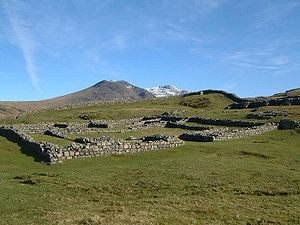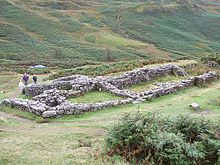- Mediobogdum
-
Coordinates: 54°24′9.82″N 3°12′19.44″W / 54.4027278°N 3.2054°W
Mediobogdum (or the Hardknott Roman Fort) was a fort in the Roman province of Britannia. Its remains are located on the western side of the Hardknott Pass in the English county of Cumbria (formerly part of Cumberland).
Contents
The location and name
It was built on a rocky spur giving a superb view over the River Esk in both upper and lower Eskdale, and protecting Hardknott Pass. The fort has been commonly known in recent times as Hardknott Castle, but identified from the Ravenna Cosmography as the Mediobogdo fort (or more correctly Mediobogdum[1]), situated along the road between the forts of Galava (Ambleside) and Glannoventa (Ravenglass).
Classical history
Built between about AD 120 and 138, the fort was abandoned during the Antonine advance into Scotland during the mid 2nd century. The fort was reoccupied c. AD 200 and continued in use until the last years of the 4th century. During this time an extensive vicus developed outside the fort.[2] The Roman garrison here was a detachment of 500 cavalry from the Dalmatian coast.
Physical description
The fort is square with rounded corners, 114 metres long externally, or 105 metres internally, the rampart wall being about 1.7 metres thick with ditches adding to the total width of the rampart. The low walls of the fort were "restored" some years ago, a slate course showing the height of the walls before their rebuilding.
The outer wall has four gates, at the centre of each side, and lookout towers at each corner. Within the walls are the remaining outlines of three buildings: a granary, a garrison headquarter building and a house for the garrison commander. In addition to these stone buildings, timber structures would have housed barracks for the legionaries.
Outside the square of the fort is the remains of the bath house (which has a rare circular sudatorium), and the levelled parade ground, which is considered to be the finest surviving example in the Western Empire.[citation needed]
The Modern site
The fort is on land owned by the National Trust, part of the Trust's Wasdale, Eskdale and Duddon property, and maintained by English Heritage.
References
External links
- Wasdale, Eskdale and Duddon information at the National Trust
- Hardknott Roman Fort information at English Heritage
- iRomans Link to website showing Hardnott's position in relation to other roman forts in Cumbria
Dating from Neolithic/ Bronze Age Dating from Roman Britain Ambleside Roman Fort · Hadrian's Wall (including Banks East Turret, Birdoswald Roman Fort, Hare Hill, Harrows Scar Milecastle and Wall, King's Stables (Milecastle 48), Leahill Turret and Piper Sike Turret, Pike Hill Signal Tower, Willowford Wall Turrets and Bridge) · Hardknott Roman Fort · Ravenglass Roman Bath HouseDating from the Middle Ages Dating from the 17th Century onwards Categories:- Buildings and structures in Cumbria
- English Heritage sites in Cumbria
- History of Cumberland
- History of Cumbria
- Military history of Cumbria
- National Trust properties in Cumbria
- Roman forts in England
- Visitor attractions in Cumbria
- Archaeological sites in Cumbria
- Former populated places in England
- Ruins in Cumbria
Wikimedia Foundation. 2010.



